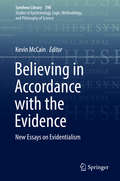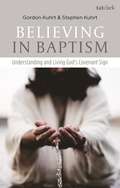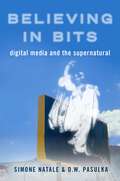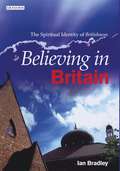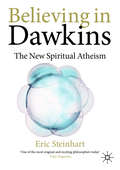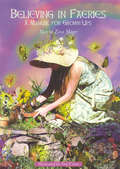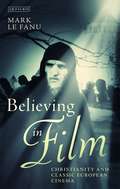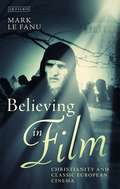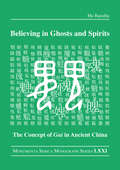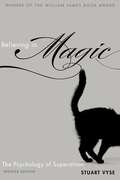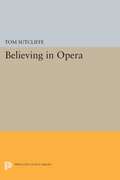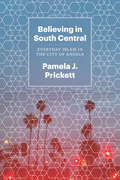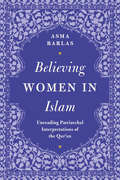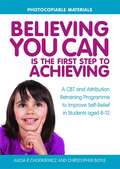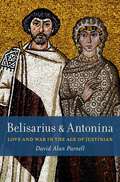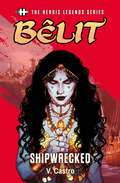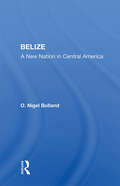- Table View
- List View
Believing in Accordance with the Evidence: New Essays on Evidentialism (Synthese Library #398)
by Kevin McCainThis volume explores evidentialism, a major theory of epistemic justification. It contains more than 20 papers that examine its nuances, its challenges, as well as its future directions. Written by leading and up-and-coming epistemologists, the papers cover a wide array of topics related to evidentialism. The contributors present both sides of the theory: some are advocates of evidentialism, while others are critics. This provides readers with a comprehensive, and cutting-edge, understanding of this epistemic theory. Overall, the book is organized into six parts: The Nature of Evidence, Understanding Evidentialism, Problems for Evidentialism, Evidentialism and Social Epistemology, New Directions for Evidentialism, and Explanationist Evidentialism. Readers will find insightful discussion on such issues as the ontology of evidence, phenomenal dogmatism, how experiences yield evidence, the new evil demon problem, probability, norms of credibility, intellectual virtues, wisdom, epistemic justification, and more. This title provides authoritative coverage of evidentialism, from the latest developments to the most recent philosophical criticisms. It will appeal to researchers and graduate students searching for more information on this prominent epistemological theory.
Believing in Baptism: Understanding and Living God's Covenant Sign
by Stephen Kuhrt Gordon KuhrtIncluding a Foreword by the Rt. Rev. Graham Tomlin, this volume examines the theology and practice of baptism. It contains a narrative introduction that highlights the different approaches taken to baptism, and the various issues that come with them. The volume also covers how the changing cultural context within Britain has influenced responses to baptism. At the heart of the book is a detailed examination of the theme of covenant running through the Bible and how this shapes its understanding of baptism.Gordon Kuhrt and his son Stephen explore several controversial issues associated with baptism. Believing in Baptism contains an in-depth discussion of the sacramental issues surrounding baptismal 'efficacy', for instance, as well as infant or family baptism. The authors also examine the 'Baptist' view, discrimination in Baptism and the issue of 'Rebaptism'. Finally, they consider the issue of 'Baptism and its Completion?', and make practical recommendations on the ways in which baptism should be taught and lived in the local church.
Believing in Baptism: Understanding and Living God's Covenant Sign
by Stephen Kuhrt Gordon KuhrtIncluding a Foreword by the Rt. Rev. Graham Tomlin, this volume examines the theology and practice of baptism. It contains a narrative introduction that highlights the different approaches taken to baptism, and the various issues that come with them. The volume also covers how the changing cultural context within Britain has influenced responses to baptism. At the heart of the book is a detailed examination of the theme of covenant running through the Bible and how this shapes its understanding of baptism.Gordon Kuhrt and his son Stephen explore several controversial issues associated with baptism. Believing in Baptism contains an in-depth discussion of the sacramental issues surrounding baptismal 'efficacy', for instance, as well as infant or family baptism. The authors also examine the 'Baptist' view, discrimination in Baptism and the issue of 'Rebaptism'. Finally, they consider the issue of 'Baptism and its Completion?', and make practical recommendations on the ways in which baptism should be taught and lived in the local church.
Believing in Bits: Digital Media and the Supernatural
Believing in Bits advances the idea that religious beliefs and practices have become inextricably linked to the functioning of digital media. How did we come to associate things such as mindreading and spirit communications with the functioning of digital technologies? How does the internetâs capacity to facilitate the proliferation of beliefs blur the boundaries between what is considered fiction and fact? Addressing these and similar questions, the volume challenges and redefines established understandings of digital media and culture by employing the notions of belief, religion, and the supernatural.
BELIEVING IN BITS C: Digital Media and the Supernatural
by Simone Natale, D. W. PasulkaBelieving in Bits advances the idea that religious beliefs and practices have become inextricably linked to the functioning of digital media. How did we come to associate things such as mindreading and spirit communications with the functioning of digital technologies? How does the internetâs capacity to facilitate the proliferation of beliefs blur the boundaries between what is considered fiction and fact? Addressing these and similar questions, the volume challenges and redefines established understandings of digital media and culture by employing the notions of belief, religion, and the supernatural.
Believing in Britain: The Spiritual Identity of 'Britishness'
by Ian BradleyWhy is there such intense interest today in the idea of 'Britishness'? Does it really matter, and what is 'Britishness' anyway? Why does the notion of 'being British' seem to have most resonance amongst recent immigrant - especially Asian and Afro-Caribbean - communities? And why is that 'traditional' British values now seem to be most widely practised and cherished by newcomers, not by the dominant majority?This book answers these vital questions by making a unique contribution to the current debate about British identity. It investigates why Liverpool is the most British of UK cities, with a regional accent representing a medley of Welsh, Scots, Irish and English; how a small village off the M6 motorway is arguably Britain's spiritual heart; and what theme parks, airport shops and eating habits have to tell us about the contemporary national character. It is often claimed that Great Britain is one of the most secular nations on earth. But – controversially – Ian Bradley argues that Britishness is best envisaged as a series of overlapping identities which are at root religious. He views the 400 year-old Union Jack, with its overlaid crosses of three of the nation's four patron saints, as symbolising the United Kingdom's unparalleled combination of unity in diversity, the diversity of a society which now embodies Muslim, Jewish, Hindu, Buddhist and many other – including secular – traditions. He goes on to argue that 'Britishness' has special value as a broad church measure of spiritual and cultural inclusiveness – and as a positive alternative to fundamentalism, narrow nationalism and jingoism. The author explores in separate chapters the distinctive contributions to Britishness made over the centuries by the Celtic traditions of the Welsh and Irish, the Anglo-Saxon strain of tolerance and freedom associated with the English, the moral seriousness of the Scots, and the characteristics of exuberance, modesty and privacy introduced by new black and Asian Britons. Published to coincide with the three hundredth anniversary of the 1707 Act of Union, his book offers a number of radical proposals. These include re-designing the Union flag to incorporate a black cross on a gold background, to better reflect the hybridity of contemporary Britain, and replacing George, Andrew and Patrick with a new trinity of patron saints – Columba, Bridget and Edward the Confessor. Ian Bradley contends that a rejuvenated BBC, monarchy and Commonwealth all have a part to play in forging a new sense of British identity which combines myth, imagination and tradition with a broad, open-minded inclusivity and respect for difference. Believing in Britain makes a consistently thoughtful and challenging contribution to one of the most important discussions of our time.
Believing in Dawkins: The New Spiritual Atheism
by Eric SteinhartDawkin's militant atheism is well known; his profound faith less well known In this book, atheist philosopher Eric Steinhart explores the spiritual dimensions of Richard Dawkins’ books, which are shown to encompass:· the meaning and purpose of life· an appreciation of Platonic beauty and truth· a deep belief in the rationality of the universe· an aversion to both scientism and nihilism As an atheist, Dawkins strives to develop a scientific alternative to theism, and while he declares that science is not a religion, he also proclaims it to be a spiritual enterprise. His books are filled with fragmentary sketches of this ‘spiritual atheism’, resembling a great unfinished cathedral. This book systematises and completes Dawkins’ arguments and reveals their deep roots in Stoicism and Platonism. Expanding on Dawkins’ ideas, Steinhart shows how atheists can develop powerful ethical principles, compelling systems of symbols and images, and meaningful personal and social practices. Believing in Dawkins is a rigorous and potent entreaty for the use of science and reason to support spiritually rich and optimistic ways of thinking and living.
Believing In Faeries: A Manual for Grown Ups
by Marcia Zina MagerOther books about faeries are just that - books about faeries, filled with myths and stories. This book is uniquely different. It is a modern day instruction manual directly from the mystical realm itself; a 'Celestine Prophecy' brought back from the natural world. It takes the reader on a rare journey into a kingdom governed by ancient principles and powerful truths that can change our planet.Believing in Faeries promises to alter the way we view the world.
Believing in Film: Christianity and Classic European Cinema (Cinema and Society)
by Mark Le FanuWe live in a secular world and cinema is part of that secular edifice. There is no expectation, in modern times, that filmmakers should be believers – any more than we would expect that to be the case of novelists, poets and painters. Yet for all that this is true, many of the greatest directors of classic European cinema (the period from the end of World War II to roughly the middle of the 1980s) were passionately interested not only in the spiritual life but in the complexities of religion itself. In his new book Mark Le Fanu examines religion, and specifically Christianity, not as the repository of theological dogma but rather as an energizing cultural force – an 'inflexion' – that has shaped the narrative of many of the most striking films of the twentieth century. Discussing the work of such cineastes as Eisenstein and Tarkovsky from Russia; Wajda, Zanussi and Kieslowski from Poland; France's Rohmer and Bresson; Pasolini, Fellini and Rossellini from Italy; the Spanish masterpieces of Buñuel, and Bergman and Dreyer from Scandinavia, this book makes a singular contribution to both film and religious studies.
Believing in Film: Christianity and Classic European Cinema (Cinema and Society)
by Mark Le FanuWe live in a secular world and cinema is part of that secular edifice. There is no expectation, in modern times, that filmmakers should be believers – any more than we would expect that to be the case of novelists, poets and painters. Yet for all that this is true, many of the greatest directors of classic European cinema (the period from the end of World War II to roughly the middle of the 1980s) were passionately interested not only in the spiritual life but in the complexities of religion itself. In his new book Mark Le Fanu examines religion, and specifically Christianity, not as the repository of theological dogma but rather as an energizing cultural force – an 'inflexion' – that has shaped the narrative of many of the most striking films of the twentieth century. Discussing the work of such cineastes as Eisenstein and Tarkovsky from Russia; Wajda, Zanussi and Kieslowski from Poland; France's Rohmer and Bresson; Pasolini, Fellini and Rossellini from Italy; the Spanish masterpieces of Buñuel, and Bergman and Dreyer from Scandinavia, this book makes a singular contribution to both film and religious studies.
Believing in Ghosts and Spirits: The Concept of Gui in Ancient China (Monumenta Serica Monograph Series)
by Hu BaozhuThe present book by Hu Baozhu explores the subject of ghosts and spirits and attempts to map the religious landscape of ancient China. The main focus of attention is the character gui 鬼, an essential key to the understanding of spiritual beings. The author analyses the character gui in various materials – lexicons and dictionaries, excavated manuscripts and inscriptions, and received classical texts. Gui is examined from the perspective of its linguistic root, literary interpretation, ritual practices, sociopolitical implication, and cosmological thinking. In the gradual process of coming to know the otherworld in terms of ghosts and spirits, Chinese people in ancient times attempted to identify and classify these spiritual entities. In their philosophical thinking, they connected the subject of gui with the movement of the universe. Thus the belief in ghosts and spirits in ancient China appeared to be a moral standard for all, not only providing a room for individual religiosity but also implementing the purpose of family-oriented social order, the legitimization of political operations, and the understanding of the way of Heaven and Earth.
Believing in Ghosts and Spirits: The Concept of Gui in Ancient China (Monumenta Serica Monograph Series)
by Hu BaozhuThe present book by Hu Baozhu explores the subject of ghosts and spirits and attempts to map the religious landscape of ancient China. The main focus of attention is the character gui 鬼, an essential key to the understanding of spiritual beings. The author analyses the character gui in various materials – lexicons and dictionaries, excavated manuscripts and inscriptions, and received classical texts. Gui is examined from the perspective of its linguistic root, literary interpretation, ritual practices, sociopolitical implication, and cosmological thinking. In the gradual process of coming to know the otherworld in terms of ghosts and spirits, Chinese people in ancient times attempted to identify and classify these spiritual entities. In their philosophical thinking, they connected the subject of gui with the movement of the universe. Thus the belief in ghosts and spirits in ancient China appeared to be a moral standard for all, not only providing a room for individual religiosity but also implementing the purpose of family-oriented social order, the legitimization of political operations, and the understanding of the way of Heaven and Earth.
Believing in Magic: The Psychology of Superstition - Updated Edition
by Stuart A. VyseWhile we live in a technologically and scientifically advanced age, superstition is as widespread as ever. Not limited to just athletes and actors, superstitious beliefs are common among people of all occupations, educational backgrounds, and income levels. In this fully updated edition of Believing in Magic, renowned superstition expert Stuart Vyse investigates our tendency towards these irrational beliefs. Superstitions, he writes, are the natural result of several psychological processes, including our human sensitivity to coincidence, a penchant for developing rituals to fill time (to battle nerves, impatience, or both), our efforts to cope with uncertainty, the need for control, and more. In a new Introduction, Vyse discusses important developments and the latest research on jinxes, paranormal beliefs, and luck. He also distinguishes superstition from paranormal and religious beliefs and identifies the potential benefits of superstition for believers. He examines the research to demonstrate how we can better understand complex human behavior. Although superstition is a normal part of our culture, Vyse argues that we must provide alternative methods of coping with life's uncertainties by teaching decision analysis, promoting science education, and challenging ourselves to critically evaluate the sources of our beliefs.
Believing in Me
by Deborah SomorinHomeless at 13, pregnant at 14: life was not working out the way Deborah had hoped. And yet, she is now a chartered accountant, management consultant, the founder of a housing non-profit and a mother to a wonderful 13-year-old boy.How was this possible? Was it due to a system perfectly constructed to enable Ireland’s most vulnerable to excel? No. In fact, many things about the care system could have failed this young life. Deborah’s success was down to two things: her sheer tenacity and the wonderful people who came into her life and found ways around the system.These ‘disruptors’ or ‘circle of allies’ include Shelly, who let Deborah spend her homeless days in a charity’s office instead of on the streets; Ciara, who paid for her grinds; and Margaret, who rewarded Deborah with make-up to stay in school. These seemingly small interventions gave Deborah what the system didn’t: the chance not only to survive but to thrive. Deborah is now one of these people herself, helping single parents pursuing a degree through her non-profit, Empower the Family.Believing in Me tells an incredible story. But it will also inspire people everywhere to reflect on those who impacted their lives and how our own actions – no matter how small – can make a significant impact on the lives of others.
Believing in Opera (PDF)
by Tom SutcliffeThe staging of opera has become immensely controversial over the last twenty years. Tom Sutcliffe here offers an engaging and far-reaching book about opera performance and interpretation. This work is a unique tribute to the most distinctive and adventurous achievements in the theatrical interpretation of opera as it has developed in recent decades. Readers will find descriptions of the most original and successful avant-garde opera productions in Britain, Europe, and America. Sutcliffe beautifully illustrates how updating, transposition, or relocation, and a variety of unexpected imagery in opera, have qualified and adjusted our perception of the content and intention of established masterpieces.Believing in Opera describes in detail the seminal opera productions of the last fifty years, starting with Peter Brook in London after the war, and continuing with the work of such directors and producers as Patrice Chéreau in Bayreuth, Peter Sellars and David Alden in America, Ruth Berghaus in Frankfurt, and such British directors as Richard Jones, Graham Vick, Peter Hall, and David Pountney. Through his descriptions of these works, Sutcliffe states that theatrical opera has been enormously influenced by the editing style, imagery, and metaphor commonplace in the cinema and pop videos. The evolution of the performing arts depends upon revitalization and defamiliarization, he asserts. The issue is no longer naturalism, but the liberation of the audience's imagination powered by the music.Sutcliffe, an opera critic for many years, argues that opera is theater plus music of the highest expressive quality, and as a result he has often sided with unconventional and novel theatrical interpretations. He believes that there is more to opera than meets the ear, and his aim is to further the process of understanding and interpretation of these important opera productions. No other book has attempted this kind of monumental survey.Originally published in 1997.The Princeton Legacy Library uses the latest print-on-demand technology to again make available previously out-of-print books from the distinguished backlist of Princeton University Press. These editions preserve the original texts of these important books while presenting them in durable paperback and hardcover editions. The goal of the Princeton Legacy Library is to vastly increase access to the rich scholarly heritage found in the thousands of books published by Princeton University Press since its founding in 1905.
Believing in South Central: Everyday Islam in the City of Angels
by Pamela J. PrickettThe area of Los Angeles known as South Central is often overshadowed by dismal stereotypes, problematic racial stigmas, and its status as the home to some of the city’s poorest and most violent neighborhoods. Amid South Central’s shifting demographics and its struggles with poverty, sociologist Pamela J. Prickett takes a closer look, focusing on the members of an African American Muslim community and exploring how they help each other combat poverty, job scarcity, violence, and racial injustice. Prickett’s engaging ethnography relates how believers in this longstanding religious community see Islam as a way of life, a comprehensive blueprint for individual and collective action, guiding how to interact with others, conduct business, strive for progress, and cultivate faith. Prickett offers deep insights into the day-to-day lived religion of the Muslims who call this community home, showing how the mosque provides a system of social support and how believers deepen their spiritual practice not in spite of, but through, conditions of poverty. Prickett breaks past the stigmas of urban poverty, revealing a complex and vibrant community by telling the stories of longstanding residents of South Central—like Sister Ava, who offers food to the local unhoused people and finds the sacred in her extensive DVD collection. In addition to her portraits of everyday life among Muslims in South Central, Prickett also provides vivid and accessible descriptions of Ramadan and histories of the mosque, situates this community within the larger story of the Nation of Islam, explores gender issues, and unpacks the interaction between African American Muslims and South Asian and Arab American Muslims, revealing both the global and local significance of this religious tradition.
Believing in South Central: Everyday Islam in the City of Angels
by Pamela J. PrickettThe area of Los Angeles known as South Central is often overshadowed by dismal stereotypes, problematic racial stigmas, and its status as the home to some of the city’s poorest and most violent neighborhoods. Amid South Central’s shifting demographics and its struggles with poverty, sociologist Pamela J. Prickett takes a closer look, focusing on the members of an African American Muslim community and exploring how they help each other combat poverty, job scarcity, violence, and racial injustice. Prickett’s engaging ethnography relates how believers in this longstanding religious community see Islam as a way of life, a comprehensive blueprint for individual and collective action, guiding how to interact with others, conduct business, strive for progress, and cultivate faith. Prickett offers deep insights into the day-to-day lived religion of the Muslims who call this community home, showing how the mosque provides a system of social support and how believers deepen their spiritual practice not in spite of, but through, conditions of poverty. Prickett breaks past the stigmas of urban poverty, revealing a complex and vibrant community by telling the stories of longstanding residents of South Central—like Sister Ava, who offers food to the local unhoused people and finds the sacred in her extensive DVD collection. In addition to her portraits of everyday life among Muslims in South Central, Prickett also provides vivid and accessible descriptions of Ramadan and histories of the mosque, situates this community within the larger story of the Nation of Islam, explores gender issues, and unpacks the interaction between African American Muslims and South Asian and Arab American Muslims, revealing both the global and local significance of this religious tradition.
Believing Women' in Islam: Unreading Patriarchal Interpretations of the Qur'an
by Asma BarlasDoes Islam call for the oppression of women? The subjugation of women in many Muslim countries is often used as evidence of this, while many Muslims read the Qur’an in ways that seem to justify sexual oppression and inequality. In this paradigm-shifting book, Asma Barlas argues that, far from supporting male privilege, the Qur’an actually affirms the complete equality of the sexes.Offering a historical analysis of religious authority and knowledge, Barlas shows how, for centuries, Muslims have read patriarchy into the Qur’an to justify existing religious and social structures. In this seminal volume, she takes readers into the heart of Islamic teachings on women, gender and patriarchy, offering an egalitarian reading of Islam’s most sacred scripture.This revised edition includes two new chapters, a new preface, and updates throughout.
Believing You Can is the First Step to Achieving: A CBT and Attribution Retraining Programme to Improve Self-Belief in Students aged 8-12 (PDF)
by Christopher Boyle Alicia ChodkiewiczBelieving You Can is the First Step to Achieving is a fun and engaging programme for students in the upper primary years that teaches the difference between helpful and unhelpful thinking, increases self-belief and in doing so increases motivation to learn. Do you ever hear students using phrases such as "I'm not smart enough to do this?" or "I know I am going to fail?" Combining techniques from Cognitive Behavioural Therapy and Attribution Retraining, this programme teaches students the link between thoughts, feelings and actions, how to challenge negative thinking and how to celebrate success. The structured programme includes a photocopiable student workbook, role play games and other activity ideas, and all of the instruction and materials needed to easily implement the programme in any school. This will be an ideal resource for educational professionals looking to increase school attainment, support students who are underachieving, and encourage healthy and happy student development.
Belisarius & Antonina: Love and War in the Age of Justinian
by David Alan ParnellA unique look at a powerful marriage in the celebrated age of Justinian Belisarius and Antonina were titans in the Roman world some 1,500 years ago. Belisarius was the most well-known general of his age, victor over the Persians, conqueror of the Vandals and the Goths, and as if this were not enough, wealthy beyond imagination. His wife, Antonina, was an impressive person in her own right. She made a name for herself by traveling with Belisarius on his military campaigns, deposing a pope, and scheming to disgrace important Roman officials. Together, the pair were extremely influential, and arguably wielded more power in the late Roman world than anyone except the emperor Justinian and empress Theodora themselves. This unadulterated power and wealth did not mean that Belisarius and Antonina were universally successful in all that they undertook. They occasionally stumbled militarily, politically, and personally - in their marriage and with their children. These failures knock them from their lofty perch, humanize them, and make them even more relatable and intriguing to us today. Belisarius & Antonina is the first modern portrait of this unique partnership. They were not merely husband and wife but also partners in power. This is a paradigm which might seem strange to us, as we reflexively imagine that marriages in the ancient world were staunchly traditional, relegating wives to the domestic sphere only. But Antonina was not a reserved housewife, and Belisarius showed no desire for Antonina to remain in the home. Their private and public lives blended as they traveled together, sometimes bringing their children, and worked side-by-side. Theirs was without a doubt the most important nonroyal marriage of the late Roman world, and one of the very few from all of antiquity that speaks directly to contemporary readers.
Belisarius & Antonina: Love and War in the Age of Justinian
by David Alan ParnellA unique look at a powerful marriage in the celebrated age of Justinian Belisarius and Antonina were titans in the Roman world some 1,500 years ago. Belisarius was the most well-known general of his age, victor over the Persians, conqueror of the Vandals and the Goths, and as if this were not enough, wealthy beyond imagination. His wife, Antonina, was an impressive person in her own right. She made a name for herself by traveling with Belisarius on his military campaigns, deposing a pope, and scheming to disgrace important Roman officials. Together, the pair were extremely influential, and arguably wielded more power in the late Roman world than anyone except the emperor Justinian and empress Theodora themselves. This unadulterated power and wealth did not mean that Belisarius and Antonina were universally successful in all that they undertook. They occasionally stumbled militarily, politically, and personally - in their marriage and with their children. These failures knock them from their lofty perch, humanize them, and make them even more relatable and intriguing to us today. Belisarius & Antonina is the first modern portrait of this unique partnership. They were not merely husband and wife but also partners in power. This is a paradigm which might seem strange to us, as we reflexively imagine that marriages in the ancient world were staunchly traditional, relegating wives to the domestic sphere only. But Antonina was not a reserved housewife, and Belisarius showed no desire for Antonina to remain in the home. Their private and public lives blended as they traveled together, sometimes bringing their children, and worked side-by-side. Theirs was without a doubt the most important nonroyal marriage of the late Roman world, and one of the very few from all of antiquity that speaks directly to contemporary readers.
Belize: A New Nation In Central America
by O. Nigel BollandIndependent from Britain only since 1981, the new nation of Belize is situated at the intersection of two cultural spheres: the English-speaking Afro-Caribbean countries and the Spanish-speaking Central American republics. Its scanty population of about 150,000 is culturally heterogeneous, and its various ethnic groups coexist in a complex pattern
Belize: A New Nation In Central America
by O. Nigel BollandIndependent from Britain only since 1981, the new nation of Belize is situated at the intersection of two cultural spheres: the English-speaking Afro-Caribbean countries and the Spanish-speaking Central American republics. Its scanty population of about 150,000 is culturally heterogeneous, and its various ethnic groups coexist in a complex pattern
Belize’s Independence and Decolonization in Latin America: Guatemala, Britain, and the UN (Studies of the Americas)
by A. ShomanBelize, a small British colony in Central America faced with a territorial claim and military threats from neighboring Guatemala, overcame disadvantages of size and power by implementing a strategy of internationalization that utilized new international norms and international organizations, in particular the Non-Aligned Movement and the United Nations. This book, written by a key player in the independence struggle, details the history of the territorial claim and of the international campaign that made it possible for Belize to achieve secure independence with all its territory despite pressures from Britain and the United States to cede land and compromise its sovereignty.
